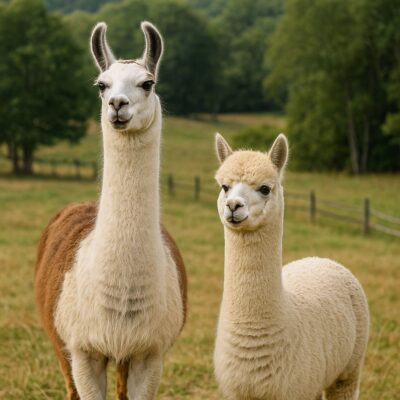 Llamas and alpacas are often confused for one another but they are not the same animal. Though both are members of the camelid family and originate from the Andes Mountains in South America, they differ significantly in size, behavior, use, and appearance.
Llamas and alpacas are often confused for one another but they are not the same animal. Though both are members of the camelid family and originate from the Andes Mountains in South America, they differ significantly in size, behavior, use, and appearance.
Welcome to Vero Q&A, where we clear up everyday questions with clarity and curiosity. Let’s break down the differences between llamas and alpacas.
Origin and Ancestry
Both llamas and alpacas have been domesticated for thousands of years and are closely related. However, they descend from different wild ancestors:
- Llamas descend from the guanaco
- Alpacas descend from the vicuña
This ancestry affects not only their appearance but also their purpose in human society.
Key Physical Differences
| Feature | Llama | Alpaca |
|---|---|---|
| Size | Larger (250–450 lbs) | Smaller (120–200 lbs) |
| Height | Up to 6 feet at the head | Around 3 feet at the shoulder |
| Face | Long face with banana-shaped ears | Short, blunt face with spear-shaped ears |
| Fur Texture | Coarse outer coat | Soft, fine fleece prized for textiles |
| Back Shape | Flat or slightly curved | More rounded |
Behavior and Temperament
Both animals are gentle, but their temperaments differ slightly:
- Llamas are confident, curious, and sometimes used as guard animals.
- Alpacas are more shy and reserved, preferring the company of their herd.
Llamas tend to be more independent, while alpacas are very social and communicate through humming sounds.
Primary Uses
| Use | Llamas | Alpacas |
|---|---|---|
| Pack Animal | Yes—used to carry loads | No—too small |
| Fiber | Less valuable (coarse) | Very valuable (soft, luxurious fleece) |
| Guarding | Used to guard livestock | Not typically used for protection |
| Companion | Often used in trekking and therapy | Popular on farms and fiber cooperatives |
Fiber & Fleece Differences
- Alpaca fleece is one of the finest and softest natural fibers in the world, often compared to cashmere.
- Llama wool is thicker and more suitable for rugs, ropes, and outerwear.
Alpacas come in over 20 recognized fleece colors, while llamas have fewer variations.
Which One is Right for You?
If you’re considering raising one:
- Choose a llama if you need a pack animal, a livestock guardian, or a more interactive trekking companion.
- Choose an alpaca if you’re interested in fiber production and a more docile, herd-oriented animal.
Both are relatively low-maintenance, hardy, and can thrive in cooler climates with good pasture and shelter.
At Vero Q&A, we make it easy to tell similar things apart. While llamas and alpacas share a lot of history and biology, their differences are just as fascinating.
Whether you’re looking at them on a farm, at a petting zoo, or in a photo online, now you’ll know exactly how to tell who’s who in the world of South American camelids.
Are llamas or alpacas more friendly?
Llamas are more confident and can bond with humans, but alpacas are gentler and prefer the herd life. They are both herd animals and often get along well in the same pasture. Both can spit, but llamas are more likely to do it, especially as a defense or to show dominance. Alpacas have superior fleece in terms of softness, warmth, and versatility for clothing. Both are hardy, need basic pasture care, shearing once a year, and regular hoof trimming. Both llamas and alpacas can live between 15–25 years with proper care.